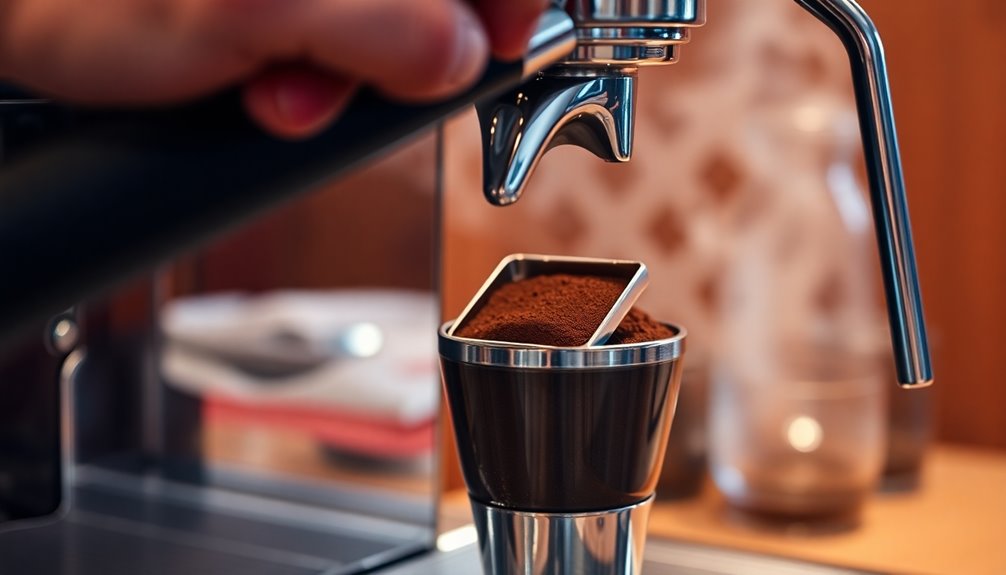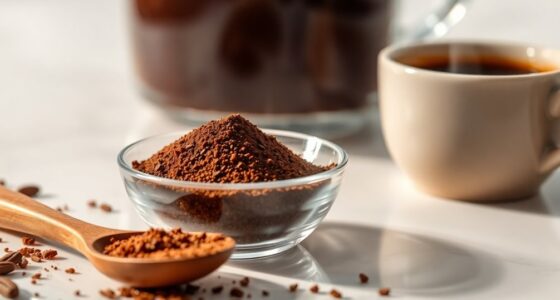Tamping plays an essential role in espresso brewing by ensuring even water flow through the coffee grounds, which enhances flavor extraction. To get it right, choose the right tamper based on your brewing style and consistently measure your coffee grounds for balanced results. Start with moderate pressure to shape the puck before applying 20-30 pounds for a well-formed coffee bed. By refining your tamping techniques, you can greatly improve your espresso quality. There’s so much more to explore!
Key Takeaways
- Proper tamping ensures even water flow, enhancing flavor extraction and preventing channeling for a richer espresso experience.
- Use a flat-bottom tamper for uniform pressure, or a convex base to reduce channeling risks.
- Aim for 20-30 pounds of pressure when tamping to achieve density and consistency in the coffee puck.
- Maintain a level tamp and finish with a gentle twist to improve puck integrity and extraction quality.
- Regularly inspect the tamped puck for gaps, and develop a routine to enhance precision and focus in tamping.
Understanding the Importance of Tamping in Espresso Quality
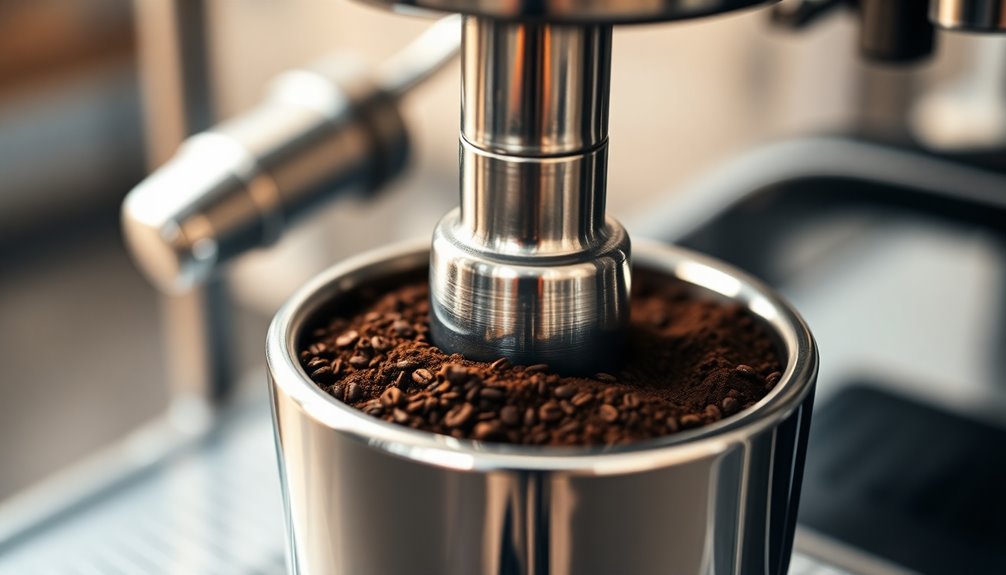
When you tamp your espresso, you’re not just pressing down on the grounds; you’re creating the resistance needed for proper water flow and extraction. This step is essential for achieving high espresso quality.
A well-tamped puck allows for ideal water saturation, ensuring that rich flavors and oils are extracted effectively. Consistent tamping pressure, ideally between 20-30 pounds, helps prevent uneven water flow, which can result in lackluster brews.
By mastering proper techniques—like leveling the grounds and eliminating air gaps—you directly impact the extraction efficiency and overall taste of your espresso. Additionally, understanding the caffeine content in espresso can help you tailor your brew to match your desired energy level.
Mastering tamping techniques, such as leveling grounds and removing air gaps, enhances extraction efficiency and espresso flavor.
With about 35% of enthusiasts recognizing tamping’s importance, it’s clear that refining this skill can elevate your brewing game, delivering a consistently bold and satisfying espresso experience.
Selecting the Right Tamper for Your Brewing Style
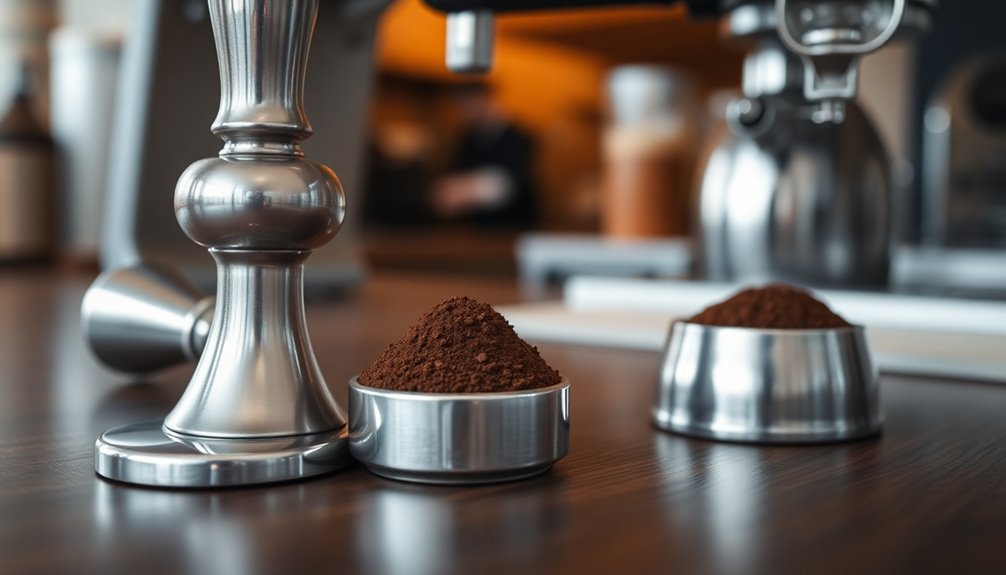
How do you choose the right tamper for your brewing style? Start by considering the design and functionality that suits you best. Think about how the tamper’s shape can affect the tamping process and ultimately your espresso shots.
- A flat-bottom tamper guarantees even pressure across the coffee bed.
- A convex base helps compress outer edges, reducing channeling risks.
- Heavier tampers provide consistent pressure, while lighter ones require more effort.
Look for calibrated tampers that apply 20-30 pounds of pressure for ideal flavor extraction. Additionally, the mechanics of French press can offer insights into how tamping techniques might influence the overall brewing experience.
Personal preference is key; experiment with different sizes and weights to find what works best for you. The right tamper can greatly enhance your espresso experience.
Preparing and Measuring Espresso Grounds
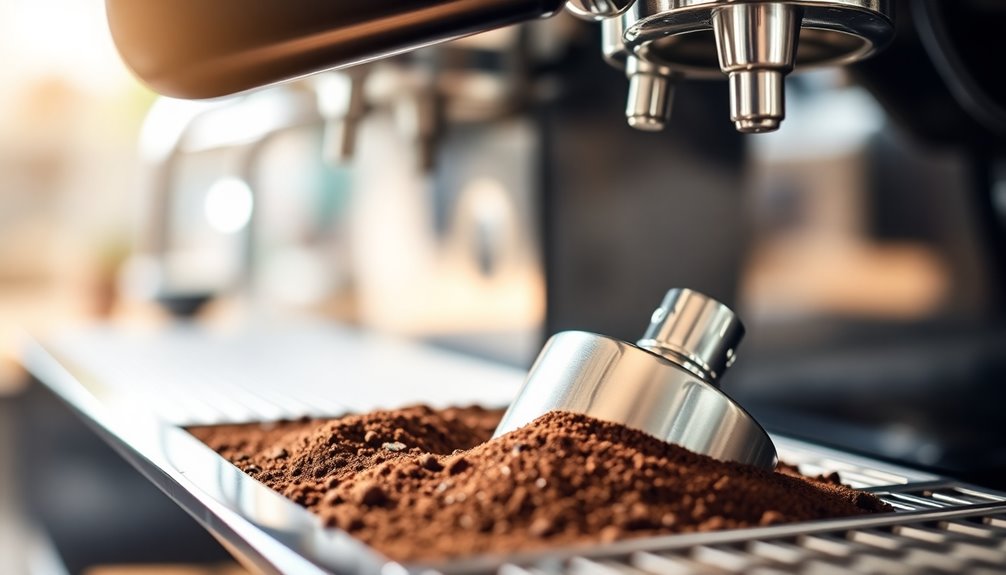
When preparing your espresso grounds, consistency in grind size is key to achieving a balanced extraction.
You’ll want to measure your coffee accurately, using a scale to guarantee you’re getting the right amount for your shots. Additionally, color accuracy plays a crucial role in the overall quality of your brewed espresso, as it can influence how the flavors are perceived.
Grinding Consistency Importance
Grinding consistency plays a pivotal role in crafting the perfect espresso. Achieving a texture slightly finer than table salt with a burr grinder guarantees ideal extraction. This consistency influences how your coffee grounds interact with tamping pressure, impacting the overall quality of your brew.
To enhance your espresso brewing experience, keep these points in mind:
- Use freshly roasted coffee beans stored in airtight containers away from sunlight.
- Aim for accurate dosing: 7-10 grams for single shots and 18-22 grams for double shots.
- Properly level your coffee grounds in the portafilter to eliminate air pockets and achieve even distribution.
Additionally, understanding investment diversification can help you appreciate the various flavors and aromas that different coffee beans can bring to your espresso.
Accurate Coffee Measurement
Achieving the perfect espresso doesn’t just rely on grinding consistency; accurate coffee measurement is equally important. For a single shot, aim for 7-10 grams, while for a double shot, you’ll need 18-22 grams.
Using a scale is the best way to guarantee precise measurement of coffee grounds, which directly impacts extraction quality and flavor. Freshly roasted beans should be ground to a consistency slightly finer than table salt to optimize extraction during brewing.
It’s also essential to level the coffee grounds in the portafilter before tamping; tapping the sides helps eliminate air pockets for even distribution. Consistency in measuring and dosing guarantees you brew your espresso properly, avoiding imbalanced extraction that can ruin the overall taste. Additionally, ensuring proper dilution ratios is crucial for achieving the right balance in any blend, whether it’s coffee or essential oils.
Mastering Tamping Techniques for Consistent Results
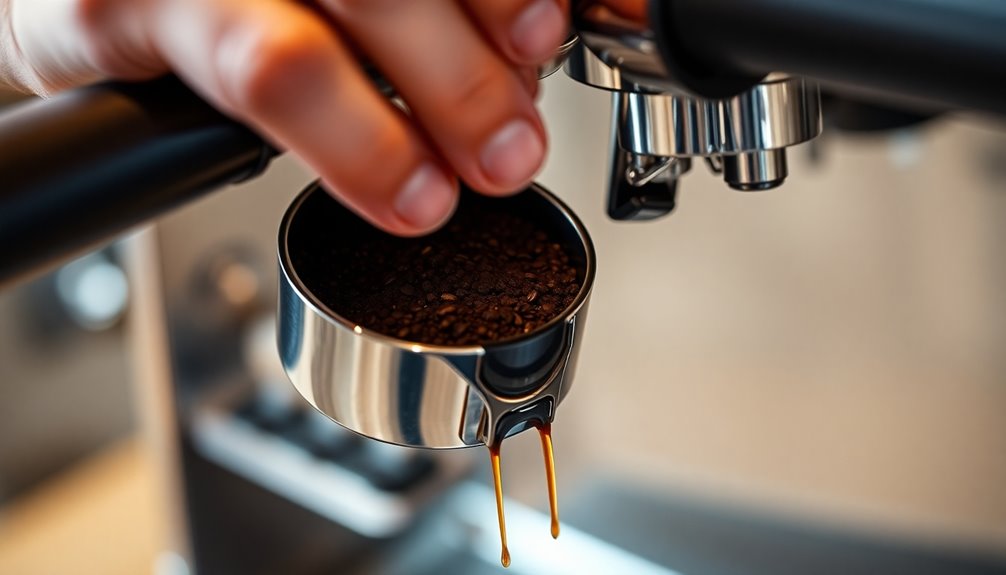
Mastering tamping techniques is essential for brewing consistent espresso, as proper compaction of coffee grounds directly influences extraction quality. To achieve this, aim to apply approximately 20-30 pounds of pressure during tamping.
Mastering your tamping technique is crucial for consistent espresso, as proper pressure directly affects extraction quality. Aim for 20-30 pounds of force.
Here are a few tips to enhance your technique:
- Always maintain a level tamp to prevent uneven extraction.
- Use a calibrated tamper to guarantee consistent pressure across each shot.
- Finish with a gentle twist to enhance the puck’s integrity.
Regularly inspect the tamped puck for gaps or loose spots, guaranteeing a smooth surface for ideal water flow through your espresso machine. Additionally, incorporating lighting design can create an inviting atmosphere that complements your coffee experience.
Common Mistakes to Avoid in Tamping

While tamping might seem straightforward, several common mistakes can compromise your espresso quality.
First, avoid pressing the tamper at an angle; this creates loose and uneven grounds, leading to uneven extraction. Make certain your portafilter is properly dosed—not overfilled or underfilled—so you achieve balanced extraction.
When tamping, resist the urge to lift the tamper too quickly, as this can create air gaps that disrupt the puck’s integrity and lead to channeling. Additionally, stay vigilant about stray coffee grounds on the side walls of the portafilter, as these can interfere with the seal.
Finally, aim for a consistent amount of pressure, targeting 20-30 pounds, to guarantee a well-formed puck that supports even extraction.
Evaluating the Quality of Your Tamped Espresso
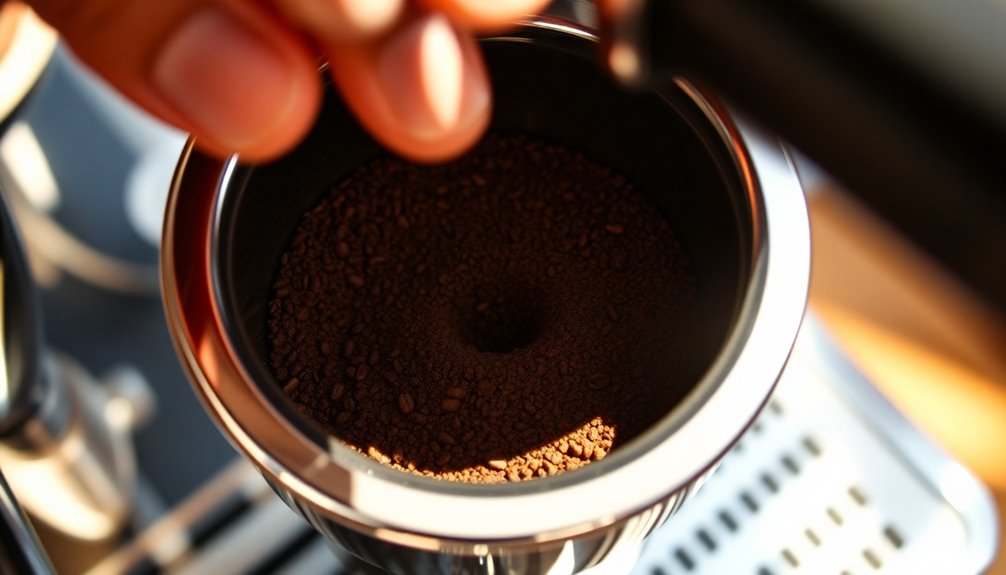
To evaluate the quality of your tamped espresso, start by inspecting the puck after brewing. A well-tamped puck of coffee should have a smooth, level surface, indicating even tamping and proper extraction.
Inspecting the puck post-brewing reveals the quality of your tamp; a smooth, level surface indicates success.
Here are key elements to take into account:
- The puck should remain intact as a single piece, reflecting successful pressure application.
- Look for consistent puck quality; any irregularities can point to tamping technique issues.
- Assess the espresso shot’s flavor and texture; ideal water flow is essential for enhancing your beverage.
Regular practice and evaluation help you refine your tamp espresso techniques, leading to café-quality results over time. Additionally, understanding the importance of milkfat in espresso can further enhance the richness and creaminess of your drink.
The Science Behind Tamping Pressure and Extraction
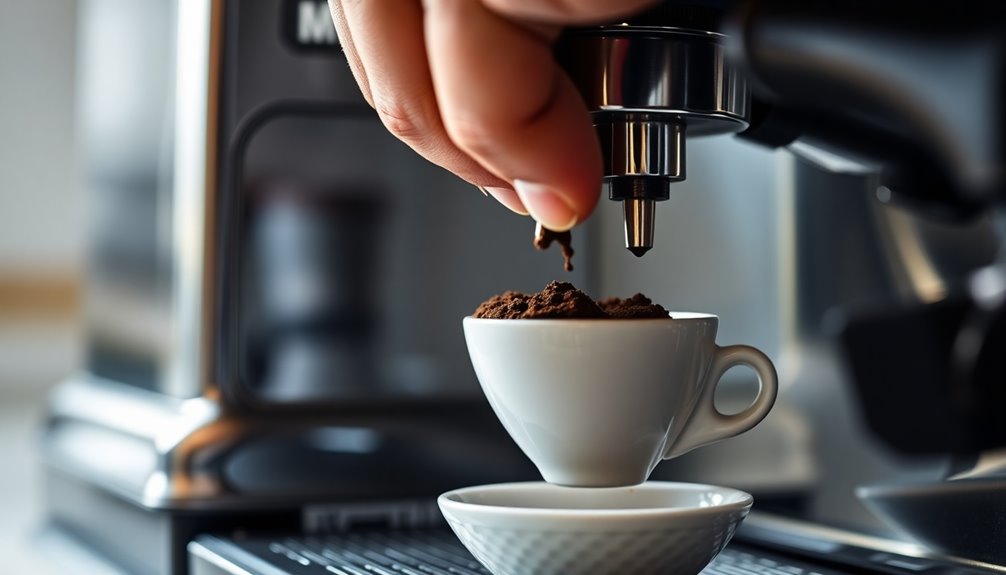
Understanding the science behind tamping pressure and extraction is essential for brewing the perfect espresso. You should aim for a tamping pressure of around 20-30 pounds, as this helps create a sturdy puck from the coffee grounds.
Start with about 15 pounds of initial pressure to shape the puck, then increase it for better density and uniformity. An even tamp guarantees water flows uniformly, preventing channeling and saturating every particle for maximum flavor extraction.
If you don’t tamp correctly, you might end up with weak flavors or bitterness. Proper resistance from the coffee puck allows for a gradual extraction, enhancing the oils and flavors, ultimately leading to a better cup when using espresso machines. Additionally, understanding the impact of mental resilience can enhance your focus and precision during the brewing process.
Enhancing Your Espresso Experience With Proper Tamping
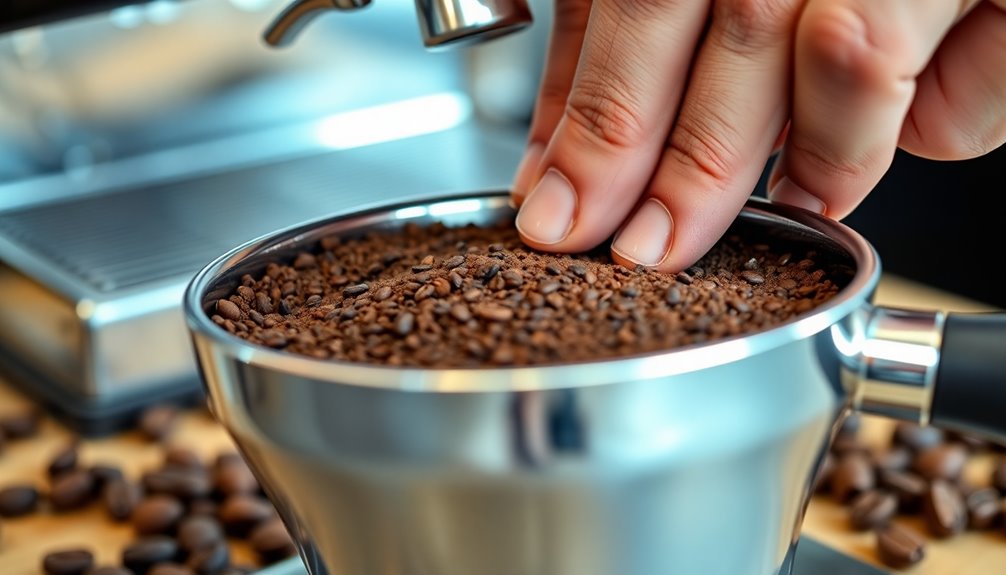
When you master the art of tamping, you elevate your espresso experience greatly. Proper espresso tamping is essential for achieving that rich, robust flavor in your shot.
Mastering tamping transforms your espresso, unlocking a rich and robust flavor that elevates every shot.
Here are key techniques to enhance your brewing:
- Apply 20-30 pounds of pressure: This creates a well-formed puck, preventing channeling.
- Level the ground coffee: An even surface guarantees ideal water flow, enhancing flavor extraction.
- Inspect your puck: Regular checks for gaps or loose spots allow you to adjust for the best espresso.
Additionally, understanding the importance of proper brewing techniques can further refine your espresso making skills.
Frequently Asked Questions
What Is the Purpose of Tamping in Espresso Preparation?
Tamping’s purpose in espresso preparation is to compress the coffee grounds evenly, creating a uniform surface for water to flow through during extraction.
When you apply the right pressure, it prevents water from bypassing the coffee, which can lead to weak shots.
By eliminating air pockets and ensuring consistency, proper tamping helps you achieve balanced extraction, enhancing the flavors and overall quality of your espresso.
Mastering this technique is key to better brews.
How to Tamp Espresso Correctly?
To tamp espresso correctly, start by measuring the right amount of coffee grounds for your shot.
Place the portafilter on a stable surface. Apply 20-30 pounds of even pressure straight down, focusing on the center. Finish with a gentle twist to smooth the top and check for stray grounds.
Avoid pressing at an angle or lifting the tamper too quickly. Regular practice will help you achieve a consistent and level puck for better extraction.
Why Is Tamping Important?
Imagine sculpting a perfect coffee sculpture, where every grain holds the promise of rich flavor.
Tamping’s essential because it forms a solid foundation for your espresso. When you apply the right pressure, you create resistance that guarantees water flows evenly through the grounds, extracting the delicious oils and flavors you crave.
If you don’t tamp correctly, your espresso can turn bitter or weak, leaving you with a less-than-stellar shot. It’s all about balance!
What Happens When You Don’t Tamp Espresso?
When you don’t tamp espresso properly, you risk uneven water flow through the coffee grounds. This can lead to channeling, making your shot weak and under-extracted.
If the puck’s too loose, water flows through too quickly, missing out on rich flavors. You’ll likely end up with gaps that disrupt resistance, resulting in a lower-quality espresso with less complexity and crema.
Inconsistent tamping means unreliable flavor profiles, diminishing your overall coffee experience.
Conclusion
To sum up, mastering tamping techniques can elevate your espresso brewing to new heights. Imagine pulling a shot that perfectly balances rich flavors and smooth crema, just like a barista at your favorite café. By avoiding common mistakes and applying the right pressure, you’ll create a consistent extraction that wows your taste buds. So next time you brew, remember: a good tamp is the secret ingredient to your perfect cup of espresso. Enjoy the journey!
